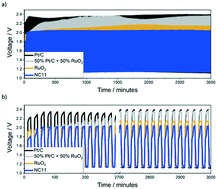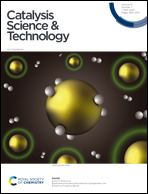Bifunctionally active nanosized spinel cobalt nickel sulfides for sustainable secondary zinc–air batteries: examining the effects of compositional tuning on OER and ORR activity†
Abstract
A range of compositionally-tuned nanosized cobalt nickel sulfides (<15 nm) were prepared via a sustainable continuous hydrothermal flow synthesis (CHFS) method and evaluated as electrocatalysts for the oxygen reduction reaction (ORR) and oxygen evolution reaction (OER) as well as air cathodes in rechargeable zinc–air batteries. The electrochemical study results showed that with the nominal composition of Ni1.5Co1.5S4, the cobalt nickel sulfide powder possesses an OER activity on a par with that of RuO2, while displaying superior cycling stability (>125 cycles) and a decent power density of 87 mW cm−2 at 150 mA cm−2 in zinc–air batteries. The electrochemical study of the series of cobalt nickel sulfides made herein suggests that a high electronic conductivity is responsible for the high bifunctional performance, with Ni(III) being identified as a contributor to the OER, while Co(II) and Ni(II) are identified as contributors to the ORR activity. These cathode materials would be highly suitable for safe, sustainable, and long-life zinc–air secondary batteries.



 Please wait while we load your content...
Please wait while we load your content...